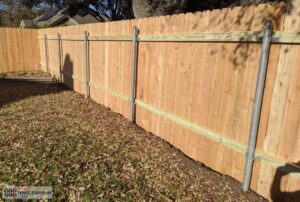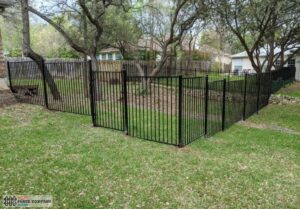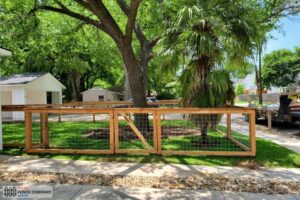Smart Gate Controllers: Wi-Fi, Backup Power & Outage Planning
TL;DR
Smart gate controllers make daily life easier and safer—until a thunderstorm or brownout hits. In Austin, the proper setup blends reliable Wi-Fi or LTE access, properly sized battery or solar backup, and a clear outage playbook so cars, deliveries, and emergency services keep flowing. We design controller packages around your slope, wind, and power reliability, then program app access, guest codes, photo eyes, and loop sensors so the gate behaves the way you expect. Suppose you’re comparing options for a new driveway gate or upgrading an older system. In that case, the team at Atlas Fence Company
will spec, install, and maintain an intelligent controller that fits Austin realities—heat, lightning, limestone dust, and all.
Table of Contents
ToggleWhy “Smart” Matters in Austin (Beyond Convenience)

Smart controllers do more than let your phone open the gate. Austin’s combination of summer brownouts, sudden thunderstorms, greenbelt dust, and steep drives means a driveway gate should be predictable on the worst day, not just the best one. We design around:
- Reliability when Wi-Fi drops (failover paths and manual releases)
- Heat management so electronics don’t derate at 105°F
- Lightning-heavy storms—surge protection and grounding so one strike doesn’t toast the board
- Delivery and service traffic—time-limited guest codes instead of handing out remotes
- HOA and curb appeal—clean pedestals, concealed wiring, and quiet operator tuning
If you’re adding a new leaf or re-engineering posts and frames, it’s smart to combine the controller upgrade with structural work so the whole system is aligned from day one. We handle that in our gate installation packages for Austin, where the opener, controller, sensing, and the physical gate are designed as a single unit—not separate gadgets zip-tied together. (Ask us how we tie controller choices to wind load and hinge geometry.)
The Controller Stack: Brains, Motor, Sensing, Connectivity
Think of a smart gate like a quiet robot at the curb:
- Controller/logic board – the “brain” that stores codes, runs auto-close timers, reacts to sensors, and talks to your phone/app.
- Operator/motor – linear actuator (swing), articulated arm (tight posts), or rack/chain drive (slide/cantilever), sized to your leaf weight and wind profile.
- Sensors & safety hardware – photo eyes, edges, loop detectors, mag locks, and gate-position encoders.
- Connectivity – Wi-Fi, Ethernet, or cellular (LTE) with app integration, plus local radio remotes as a backup.
- Power architecture – AC mains + battery; optional solar; surge suppression; proper grounding in limestone soils.
The magic is in the programming and tuning—how long it waits to close, how soft it starts/stops, how it reverses when a dog darts under the leaf, and which credentials work at which hours.
Wi-Fi vs LTE vs Local-Only: Picking a Connection That Actually Works
Austin neighborhoods can be quirky when it comes to signals. Here’s how we choose:
- Wi-Fi (2.4 GHz preferred)
- Great when your house router reliably reaches the apron. We mount a weather-rated bridge or directional antenna if the garage signal is weak. Bonus: fast app response, low operating costs.
- LTE/Cellular
- Best for long drives, stone walls, or guest houses where Wi-Fi is unrealistic. Uses a small data plan. We position the antenna away from metal columns and test multiple carriers at the curb.
- Local-only with radio remotes
- Still useful as a fallback even on intelligent systems. Remotes work when the internet is down; we set a reasonable auto-close and keep safety sensors active.
Pro tip: Many systems allow hybrid connectivity—Wi-Fi primary with LTE failover. That means your app still works when your ISP is down during a storm.
App Access, Codes & Roles: Who Gets In (and When)
A smart gate shines when you stop handing out physical remotes.
- Owner accounts – full privileges: open/close, schedules, logs, and code creation.
- Family users – everyday access but no settings.
- Temporary codes – dog walkers, cleaners, construction crews. Set day/time windows or single-use codes to end headaches.
- Delivery notes – post a QR placard at the pedestal that opens a call widget to request a one-time code while you watch them on camera.
- Geo-fencing – phones act as remotes as you approach; we tune the radius so it doesn’t open when you’re just walking the dog past the curb.
We also map guest paths so service people don’t need to cycle the big leaf to reach the side yard—pair your driveway system with a self-closing pedestrian gate and code latch.
Sensors & Safety: Photo Eyes, Loops, Edges, and Smart Auto-Close

Safety comes first, especially where kids, pets, and busy streets mix.
- Photo eyes (beam sensors) stop and reverse when an object crosses the line—place them smartly for crawl-under and bumper-height threats.
- Edge sensors detect contact at the leading/trailing edges, which are critical on slide/cantilever gates near stone columns.
- Vehicle loops under the apron prevent the gate from closing on a car and can auto-open on exit (set delays to stop tailgaters).
- Soft-start/soft-stop reduces shake and keeps hardware tight, cutting nuisance reversals.
- Smart auto-close timers close after a set delay only when all sensors are clear. We often set different timers for daytime vs night.
In hilltop wind, we’ll specify positive stops and magnetic latches so the leaf doesn’t bounce the sensor and re-open endlessly on gusty days.
Backup Power: Batteries, Solar, and Right-Sizing for Texas Heat
Outages are the moment your controller’s design shows. We consider:
- Battery chemistry & size – We right-size amp-hours to your panel weight, cycle count, and wind profile. Heat is brutal on batteries; we install in vented, shaded enclosures and service on a schedule.
- Solar assist – Great for long runs and rural lots; we confirm sun path and panel placement so trees/greenbelt shade don’t starve the charger. Solar extends runtime, but should not be your only plan in deep shade.
- Manual release – Every system comes with a clearly labeled, homeowner-tested manual release so you can swing or slide the panel by hand if the electronics fail.
- Charger & surge – Smart chargers maintain batteries without cooking them in August; surge protectors and proper grounds save power boards during lightning bursts.
Want a feel for project budgeting when a controller upgrade pairs with a new leaf or frame? Our cost guide on driveway gate pricing in Austin walks through opener choices, power, and controls in plain English to set expectations.
Outage Planning: What Happens When the Lights Go Out
Plan it now so it’s routine later:
- Default position – Do you want the gate to fail secure (stay closed) or fail safe (swing/slide to open) after X minutes of power loss? We’ll set that based on your street, neighbors, and emergency access needs.
- Emergency access – We provide an exterior fire/EMS access option if your jurisdiction requires it (Knox key switch, strobe sensor, or coded keypad path).
- Manual release drill – We show every adult in the home how to override the gate mechanically and where to park cars so you’re not trapped.
- Guest notice – A small plaque with your backup call number or QR to message you avoids a 10 p.m. lockout panic for visiting family.
- Battery test schedule – Quarterly button-tests plus an annual deep test to confirm real runtime.
Storm Proofing: Lightning, Dust, and Flood Considerations
Austin storms are flashy and fast.
- Lightning & surges – We add surge suppression on the AC feed and low-voltage lines, then bond posts and operators to a proper ground. In limestone soils, we verify ground rod performance (yes, it matters).
- Dust & pollen – Enclosures get gaskets and filters; we place photo eyes where limestone dust and cedar pollen can’t cake them in a week.
- Flood-prone aprons – Track sliders hate gravel and sheet flow; consider a cantilever. We elevate enclosures and junction boxes and seal low splices.
- Heat soak – Controllers derate at high temps; we position boxes in shade and spec light-colored enclosures or heat-reflective shields.
Privacy & Data: Security Settings Homeowners Should Actually Use
- Unique admin credentials – Change the factory login; use a password manager.
- Per-user codes – No shared “1234.” Time-box contractor codes; auto-expire them on Friday at 6 p.m.
- Event logs & alerts – Turn on open/close notifications and weekly digests to highlight odd patterns.
- Camera pairing – A small pedestal camera or soffit camera gives you eyes on the apron; pair it in the same app if the ecosystem allows.
- Network hygiene – Put the gate controller on a guest VLAN or IoT SSID; don’t give it the same network as your work laptop.
Real-World Scenarios (Austin Lots)
1) Westlake, Crowned Street, Evening Wind
- Gate type: Cantilever with cedar infill on a steel frame.
- Connectivity: Wi-Fi primary via directional bridge; LTE failover.
- Power: AC with 24Ah battery; surge suppression; shaded enclosure.
- Controls: App access + exit loop; guest code windows for landscaper.
- Why it works: No ground track to clog; wind-resistant panel; app control even when ISP hiccups.
2) Circle C, Rising Drive Toward House, Short Apron
- Gate type: Sliding (rack-and-pinion) to avoid swing drag.
- Connectivity: House Wi-Fi reaches fine; no cellular needed.
- Power: Battery backup sized for 10–12 cycles during a typical outage.
- Controls: Geo-fence open for family; time-boxed codes for cleaners.
- Safety: Dual photo eyes + edge sensor at column; smart auto-close 15s.
- Result: Smooth daily entries, no car shuffle, fails safely.
3) Steiner Ranch, Long Drive, Patchy Wi-Fi
- Gate type: Bi-swing with articulated arms, magnetic latch.
- Connectivity: LTE controller with external antenna; radio remotes as a failback.
- Power: Solar assist on a south-facing panel + AGM battery; manual release tested.
- Storm plan: Elevated pedestal, sealed conduit; lightning arrestor on the line.
- Result: App control without trenching new Ethernet; reliable in outages.
Maintenance & Updates: Keep It Smart Over Time

- Quarterly: Clean photo eyes, blow dust from enclosures, check antenna coax, run a battery self-test, and lubricate hinges/rollers.
- Bi-annual: Firmware/app updates, re-tighten low-voltage screws, verify loop sensitivity and reversal forces, test manual release with the family.
- Annual: Replace weather-cracked keypad boots, confirm ground resistance, and review access lists—purge old codes.
If your leaf or frame is aging, remember that intelligent control can’t compensate for structural drift. When posts lean or hinges wear, sensors can nuisance-trip, and motors can overwork. Pair electronics with sound structure—our fence replacement team in Austin can rebuild the weak link so the controller doesn’t spend its life fighting physics.
FAQs
Yes—your radio remotes, keypads, and loops keep working. App control resumes when Wi-Fi/LTE returns. We can also set a local-only open/close via hard buttons.
Depends on panel weight, wind, and cycle count. We typically size for 8–15 complete cycles over 24 hours, so you’re not trapped during a storm.
Both can be secure if appropriately configured. The bigger risk is shared codes and weak admin passwords. Use per-user codes and change them seasonally.
Often, yes. We assess hinge health, roller alignment, and power first. Sometimes a minor structural tune-up turns a frustrating opener into a flawless one.
In sunny areas, solar assistance paired with batteries works well for moderate usage. Deep shade or high cycle counts still favor AC mains with battery backup.
Ready for a Smart Gate Walkthrough?
We’ll map your signal, shade, slope, and storm risks, then spec a controller, power plan, and safety stack that work every day—not just day one. For new builds, we align leaf, posts, opener, and controls in one cohesive package; for retrofits, we tune what you have and add what you actually need. Start here to get a tailored plan and pricing: request a fence-and-gate estimate or call (512) 366-8108.
